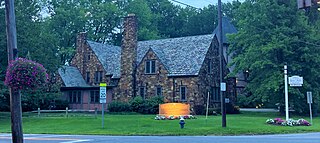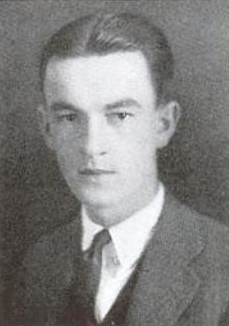
Hudson is a city in northern Summit County, Ohio, United States. The population was 23,110 at the 2020 census. It is a suburban community in the Akron metropolitan area. John Brown made his first public vow to destroy slavery here and the city later became part of the Underground Railroad. The Village of Hudson and Hudson Township were formerly two separate governing entities that merged in 1994.

Case Western Reserve University (CWRU) is a private research university in Cleveland, Ohio. Case Western Reserve was established after Western Reserve University—which was founded in 1826 and named for its location in the Connecticut Western Reserve—and Case Institute of Technology—which was founded in 1880 through the endowment of Leonard Case Jr.—formally federated in 1967.

Benedictine College is a private Benedictine liberal arts college in Atchison, Kansas, United States. It was established in 1971 by the merger of St. Benedict's College for men and Mount St. Scholastica College for women. It is located on bluffs overlooking the Missouri River, northwest of Kansas City, Missouri. Benedictine is one of a number of U.S. Benedictine colleges and is sponsored by St. Benedict's Abbey and Mount St. Scholastica Monastery. The abbey has a current population of 53 monks, while the Mount monastery numbers 147 community members. The college has built its core values around four "pillars" — Catholic, Benedictine, Liberal Arts, Residential — which support the Benedictine College mission to educate men and women in a community of faith and scholarship.

Montgomery Bell Academy (MBA) is a preparatory day school for boys in grades 7 through 12 in Nashville, Tennessee. The school is located in the Whitland Area Neighborhood.

Kent School is a private, coeducational, college preparatory boarding school in Kent, Connecticut, established by Frederick Herbert Sill in 1906. It is affiliated with the Episcopal Church of the United States. It has a long history as an "elite school, not a school for elites," and innovated the sliding-scale tuition model in the early 20th century.

Chaminade College Preparatory School is an independent, Catholic school, administered by the Marianist Order for boys in grades six through twelve in the Archdiocese of St. Louis. The school is located in Creve Coeur, Missouri.
Columbus Academy (CA) is a selective, independent college-preparatory school for students from pre-kindergarten to twelfth grade. The school is located on a large, secluded campus surrounded by wooded areas in Gahanna, Ohio, in the United States, 8 miles from downtown Columbus. The academy was founded in 1911 by J. L. Hamill in Bexley, Ohio, and moved to its current campus in 1968. Originally an all-boys school, it became coeducational in 1991 when the board of trustees decided to admit girls. From its conception, the school expanded over time to a matriculation level of 1,000 students. Columbus Academy students and alumni often refer to the school as "Academy."

New York Military Academy (NYMA) is a college preparatory, co-ed boarding school in the suburban town of Cornwall, 60 miles (97 km) north of New York City, and one of the oldest military schools in the United States. Originally a boys' school, it started admitting girls in 1975. On March 3, 2015, NYMA filed for Chapter 11 bankruptcy protection, and was sold at auction to Chinese-owned foundation Research Center on Natural Conservation Inc. which reopened the school in November 2015. The Research Center then poured millions of dollars into the campus to support instruction and capital improvements. The campus also has been host to popular camps like Camp All America into the 1980s and currently the NYMA Leadership Program.

The Storm King School (SKS) is an independent coeducational boarding and day school in the U.S. state of New York. Established in 1867, it is one of New York's oldest boarding schools. It is a college preparatory school for students in grades 8 to post-graduate, with an enrollment of 195 and 37 faculty living on or near campus through the year.

Gilmour Academy is an independent, Catholic, coeducational, college-preparatory day and boarding school in the Cleveland suburb of Gates Mills, Ohio, United States. Founded in 1946 by the Brothers of Holy Cross, Gilmour Academy has three divisions, Lower School, Middle School and Upper School. In the Lower School, Gilmour offers a Montessori preschool program for 18 months - PreK. The Lower School also houses the children in kindergarten through Grade 6. Gilmour's Middle School holds 7th and 8th grades, and, as of the 2021-2022 school year, has 65 students. At nearly 500 students, Gilmour's Upper School has grades 9-12. A boarding program is available to students in grades 9–12.
West Nottingham Academy is an independent co-ed school serves both boarding and day students in grades 9-12. It was founded in 1744 by the Presbyterian preacher Samuel Finley, who later became President of The College of New Jersey, which is now Princeton University. The 124-acre (0.50 km2), tree-lined campus is in Colora, Maryland near the Chesapeake Bay, an hour south of Philadelphia and 45 minutes north of Baltimore.

IMG Academy is a preparatory boarding school and sports training destination in Bradenton, Florida, United States. The organization is set across over 600 acres and features programs consisting of sport camps for youth athletes, adult camps, a boarding school, including a post-graduate/gap-year program, events, professional and collegiate training, group hosting, and corporate retreats.

Shady Side Academy is an independent preparatory school located in the Borough of Fox Chapel, and in the Point Breeze neighborhood of Pittsburgh, Pennsylvania. Founded in 1883 as an all-male night school in the Shadyside neighborhood of Pittsburgh, the academy now offers a secular coeducational PK–12 program on four campuses in the city and its suburbs, including a boarding program in the Croft and Morewood Houses of its Senior School Campus.

Trinity-Pawling School, is an independent, college-preparatory boarding school for boys from 7th to 12th grade in Pawling, New York, United States. The school, located on a 230-acre campus in southern Dutchess County, is located 60 miles north of New York City.

Andrews Osborne Academy (AOA) is a private, coeducational boarding and day school for Grades Pre-K -12 located on 300 acres (1.2 km2) of land in Willoughby, Ohio, twenty miles (32 km) east of Cleveland. The student body is 73% day students and 27% boarding students, 51% male and 49% female, representing 4 states and 20 countries.
Middleburg Academy Middleburg Academy was a co-educational, nonsectarian, independent secondary school, set on a historic campus of more than 95 acres (38 ha) in Middleburg, Virginia. On June 17, 2020 Middleburg Academy announced its full closure.

The Winchendon School is a coeducational, preparatory boarding and day school composed of two campuses; one in Massachusetts, and another in Herald Square, Manhattan, New York. Founded in 1926, The Winchendon School has an average classroom size of eight students, an enrollment of approximately 325 students on the two campuses, and a student to teacher ratio of 6:1

The Hudson Historic District is a historic district located in Hudson, Ohio. It was added to the National Register of Historic Places in 1973.

Loomis Observatory is the second oldest observatory in the United States, located in Hudson, Ohio. Construction was completed in 1838. It is on the campus of Western Reserve Academy, a college preparatory school. When the observatory was constructed the school was Western Reserve College, which later repaired to Cleveland and is now known as Case Western Reserve University.

Joseph Frederick Waring was an American scholar, preservationist and author. A Yale College graduate, he went on to teach at several schools, including over thirty years at the Western Reserve Academy. He also wrote three books.



























